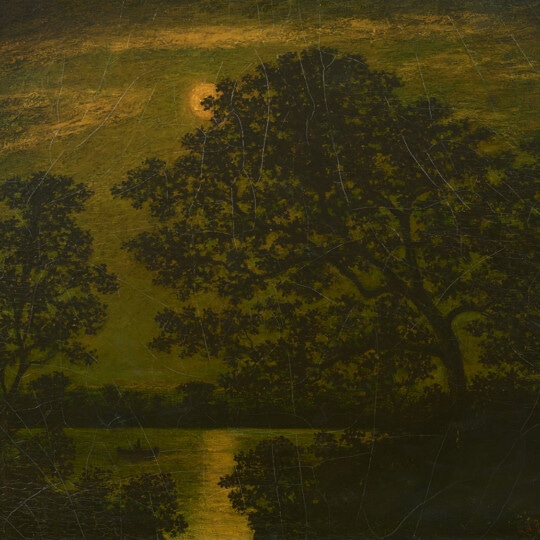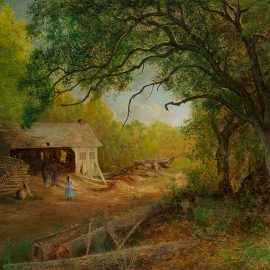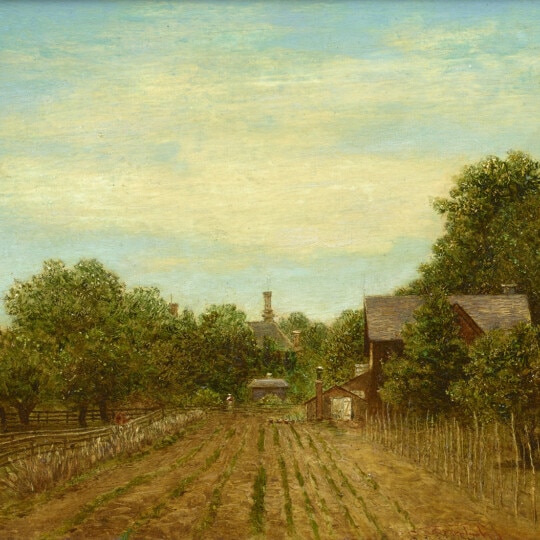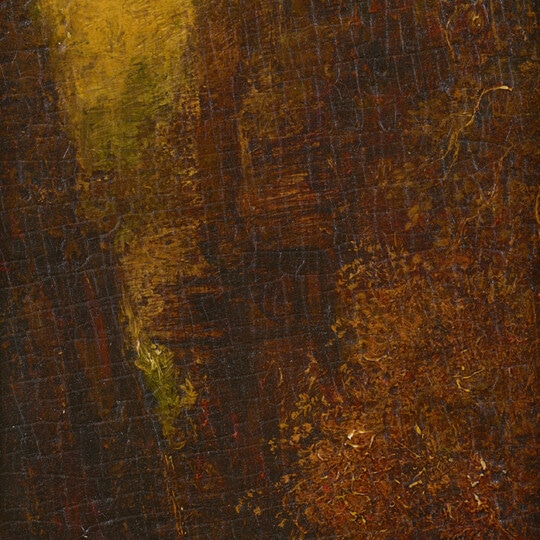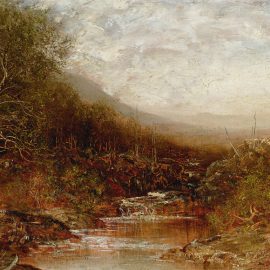Ralph Albert Blakelock
Artist Biography
ONE HUNDRED YEARS AGO, in the backwoods of Upstate New York, he languished in a mental institution as his paintings began to break American records. So great was his fame that at an auction in the Plaza Hotel ballroom the total realized for his paintings exceeded the totals for the Monets, the Rembrandts, the Renoirs, the Pissarros, and the Botticellis.
Forever true to his own vision, he lived in abject poverty in the years before he was institutionalized, and even then he never ceased painting, pulling out his own hair for brush bristles and using tobacco juice to augment the meager supply of paint he possessed.
His influence and admiration reached across every genre of painting. The Ashcan leader and revered teacher Robert Henri admired his work. William Merritt Chase, the premier impressionist and member of the elite group known as The Ten, purchased his work. The most distinguished modernists recognized his brilliance; George Bellows called him a genius, and Marsden Hartley thought his work was a plausible basis for a genuine American art. Pop art star Andy Warhol owned his work, he was abstract expressionist master Franz Kline’s favorite artist, and contemporary realist Jamie Wyeth has a Blakelock in his current collection.
The critics were equally as ebullient. Headlines about Ralph Albert Blakelock were often found on the front pages of the leading newspapers:
One of the greatest artists America has produced.
—The New York Times, 1942
He made a strong impression not only upon American art, but upon the art of the world.
—New York Tribune, 1916
[Among] a small group of about the strongest individualists in the history of art.
—The New Yorker, 1947
Ralph Albert Blakelock (1847–1919)
By Nina Sangimino
I. Biography
II. Chronology
III. Collections
IV. Exhibitions
V. Memberships
VI. Notes
VII. Suggested Resources
I. Biography
There will soon be held in New York an exhibition of paintings which will be of unusual interest, since it will recite, in terms of weird tonality, one of the saddest romances of American art — the story of a man whose genius and ambition enabled him to master his profession without the aid of instructors, who dreamed strange dreams and told them in remarkable color schemes till the tread of reason broke under the strain, and who now languishes in an asylum, his former art scarcely a recollection.[1]
At the time of his death on August 9, 1919, Ralph Albert Blakelock was hailed by the London Times as “one of the greatest of American artists.”[2] Yet he had spent almost all of the previous eighteen years confined to a mental institution, separated from a family who was living in extreme poverty, and without access to the art materials he had used to create his masterpiece moonlight scenes. Despite these hardships, he created an incredibly unique, visionary, and modern body of work that continues to inspire audiences a century later.
Blakelock was born on Christopher Street in New York City, on October 15, 1847, to an English carpenter, who would later serve as a police officer before becoming a homeopathic doctor. His uncle James A. Johnson, a choirmaster with such influential acquaintances as James Renwick Brevoort (1832–1918) and Frederic Church (1826–1900), became Blakelock’s cultural mentor, introducing him from a young age to music and painting.[3] Initially intending to follow in his father’s medical footsteps, Blakelock enrolled in the Free Academy of the City of New York (later City College) in September 1864. Although he excelled in drawing classes, they proved uninspiring for the burgeoning artist, and in 1866 he dropped out to begin painting full time. He first exhibited at the National Academy of Design in 1867, and two years later set out on his inaugural Western trip. This journey proved to be crucial to his artistic vision and an influence on his work for the rest of his life. While cross-country trips were becoming somewhat common among nineteenth-century artists, most famously Albert Bierstadt (1830–1902) and Thomas Moran (1837–1926), they were typically embarked on as part of government sponsored expeditions. Blakelock, however, traveled alone. By railroad and stagecoach he made his way through the territories of Nebraska, Kansas, Colorado, Wyoming, Utah, Nevada, and California.[4] While the expansiveness and wonder of the landscape impressed him, as it did other artists, it was the time spent with various American Indian tribes that had a particular effect. From Fort Pierre in present-day South Dakota, he traveled into the wilderness alone on horseback and spent time with tribes of the Great Sioux Nation.[5] At a moment when Native Americans were still holding onto many of their traditional practices as white expansion was rapidly taking hold around them, Blakelock felt that they provided a mystical and ancient connection to nature. Indian encampments became a major theme in Blakelock’s work, but rather than purely historic scenes, like those created by George Catlin (1796–1872), Blakelock applied his unique vision to the landscape of the West. As Mark Mitchell describes, “they were documents of his experience and observations, but with time they became documents of his memory, as well as the memory of the nation at large.”[6] His early Western landscapes and primeval forests foreshadowed the style he would later develop, in which mood superseded the importance of geographical detail.
When Blakelock returned to New York he listed himself as an artist in the city directory and rented his own studio space.[7] He was exhibiting regularly at the National Academy of Design, and, at first, still emulating the Hudson River School style. It was during this time that he painted the extraordinary Indian Encampment Along the Snake River (1871, American Museum of Western Art—The Anschutz Collection).[8] Working in the city, he drew inspiration from the landscape surrounding him just as he had on his travels. Inspired by urban life, he continued to forge his own path. Beginning in the 1860s and persisting after his return to New York, Blakelock ventured to the undeveloped northern edges of the city (at that time the area surrounding 55th Street and into Central Park) and painted the shanties growing up out of earth. These works began to take on a looser and more expressive style, and again focused on a unique existence, unlike the scenes of leisure present in the works of his contemporaries.
In 1877, he married Cora Rebecca Bailey and they welcomed the first of nine children. The young artist struggled to support his new and quickly growing family. He sometimes took jobs as an art teacher and later would paint plaques at E. C. Meekers Art Novelty Shop in New Jersey while he and his family lived nearby in East Orange.[9] He produced many small, swiftly finished works for the purpose of a quick sale, and at times, in the interest of generating cash, undervalued his paintings and sold them for far too little. Described by Cora in a 1908 letter to art dealer Robert Vose, “His best work took a long time to complete and in the meantime he had to live. Pictures were painted to keep things going. He could paint a really good picture in less time than anyone else I ever saw.”[10]
Financial success eluded him, in part because he sold his art directly rather than through a gallery or dealer. Despite this, he managed to garner a fair amount of prestige and his work was sought by some of the most important collectors, including Catholina Lambert, Thomas B. Clarke, Senator William A. Clark, William T. Evans, and Lew Bloom, a popular vaudeville star. In 1879, Blakelock received his first review, which appeared in the New York Times, for works hanging at the National Academy of Design. In 1883, he moved into the prestigious Tenth Street Studio Building, alongside such masters as William Merritt Chase (1849–1916) and Frederic Church. The 1884 Society of American Artists exhibition continued his climb to fame as he received recognition in the Tribune and Mail Express, and his paintings were lauded by the World as being “among the best works shown,” and in the Times as “rich and powerful.” Clarence Cook of the Tribune wrote that it was “the best work of his which we have seen, marked not only by rich coloring, but by the possession of a distinctive character.”[11]
Unanimously identified as a colorist by reviewers, it was during this period of mounting achievement that Blakelock began to focus on his most celebrated and iconic moonlight scenes. He departed from copying a real place and instead imagined landscapes, using color and technique to create a mood and evoke a powerful response in the viewer. This was unlike other landscape painters at the time. Even Albert Pinkham Ryder (1847–1917), to whom he was typically linked in critical reviews, used strong literary references as inspiration, whereas Blakelock turned totally inward for inspiration. The unique process he developed to create the recognizable silhouettes of his lace-like trees against a silvery, glowing moonlit sky placed an emphasis on abstraction and expression, and his focus on material and surface were surprisingly modern for the 1880s. He worked in multiple layers of paint and varnish, and rubbed and scraped into his works to create a landscape totally unlike the Hudson River School–inspired works of his early years:
But the man was a born colorist, and he secured tones and combinations of pigment that few have discovered. His process was slow and laborious; sometimes years would elapse from the beginning to the end of his pictures, and many years at that. He piled on pigment and he scraped, he varnished and he repainted, and he was likely at the last to completely change his theme once he had the proper foundation of paint on the canvas or panel…. It was feeling, pure and simple, like the improvisations of some gifted musician, who secures the harmonies and sweetness of his instrument unconsciously and intuitively.[12]
At the same time as this burgeoning success, he was still struggling both financially and personally. In 1886, the popular Harper’s Weekly singled out his A Waterfall, Moonlight (The Metropolitan Museum of Art) displayed at the National Academy of Design, and hailed it as “the best landscape in the exhibition,” the author admitting “an unmixed surprise at seeing attributed to him a landscape so powerful.”[13] But it was also the year of the birth of his fifth child and, tragically, the death of his two-year-old daughter. The stress continued to mount until March 1890, when he suffered his first mental breakdown and was taken by his brother to Flatbush Insane Asylum. The brief time he spent there served him well and when he was released Catholina Lambert allowed Blakelock, Cora, and their four children to come to his estate in Hawley, Pennsylvania, to convalesce. Upon their return to New York, Blakelock began working out of fellow artist and later president of the National Academy of Design Harry Watrous’s (1857–1940) studio in the Sherwood Building. It was here that Blakelock painted his masterpiece Brook by Moonlight (Toledo Museum of Art). Blakelock enjoyed a few years respite where he continued painting and exhibiting, but the family moved constantly, including stints with Cora’s parents in Brooklyn. In 1899, on the day of the birth of his ninth child, he was again admitted to Long Island State Hospital at Flatbush. He was finally taken to Middletown State Homeopathic Hospital in June 1901, where he was treated for dementia praecox, equivalent to the modern diagnosis of schizophrenia; he would remain there almost continuously until his death. Initially confined to a secluded ward and treated with hot baths that were meant to have a calming effect, he was soon placed in an open ward where he had the freedom to move about the grounds and even the nearby village.[14] He continued to find inspiration in his surroundings and sketched and painted with whatever meager materials were available to him; many works from this period are on scrap pieces of wood, board, and cigar box lids. Ironically, the moment of his greatest triumph came while he was confined to Middletown. In 1916, Brook by Moonlight sold at auction from the Catholina Lambert collection for $20,000, setting the record for the largest amount ever paid at auction for a living American artist.[15] Later that year he was finally elected to full membership at the National Academy of Design.
The media uproar that surrounded the record-breaking sale of Brook by Moonlight brought the “mad” artist to the attention of the dubious Mrs. Beatrice Van Rensselaer Adams.[16] She decided to champion Blakelock and organized a Blakelock Fund, supposedly to help support the artist and his family, and mounted the landmark Reinhardt Galleries exhibition. Dr. Maurice Ashley, superintendent at Middletown, agreed to release Blakelock into Mrs. Adams’s care for the day so that he could attend the opening. The media coverage was remarkable and attracted more than 2,500 visitors in only two weeks, among them European royalty and influential modern artists Robert Henri (1865–1929) and George Bellows (1882–1925).[17] Sadly, the monies from the Blakelock Fund mysteriously never reached Cora and the family, and Mrs. Adams was granted increasing custody over the artist, moving him without his wife’s or children’s knowledge and denying their requests to visit him. Her publicity savvy did however succeed in getting Blakelock’s name on the front pages of newspapers nationwide, and at the time of his death he was so well known that President Woodrow Wilson sent his regrets that he could not attend the funeral.[18]
While he has always remained somewhat on the fringe of mainstream American art history, as he did in life, Blakelock has been rediscovered and celebrated by every generation in the century since his death. In 1947, he was honored with an exhibition at the Whitney Museum of American Art curated by Lloyd Goodrich. In 1969, David Gebhard and Phyllis Stuurman organized the traveling exhibition The Enigma of Ralph A. Blakelock, 1847–1919, and Dr. Norman Geske began the monumental task of identifying and cataloguing works by the prolific artist. In 1996, Abraham Davidson published the most complete monograph on the artist, followed in 2003 by the acclaimed biography The Unknown Night: The Genius and Madness of R. A. Blakelock, An American Painter by Glyn Vincent. Questroyal Fine Art, whose owner Louis M. Salerno has recognized the brilliance of Blakelock for decades, mounted a major exhibition on the artist in 2005, which for the first time in the gallery’s history sold all available paintings on opening night. The most recent examination of the artist was nearly eight years ago in a show co-organized by the Sheldon Memorial Art Gallery and National Academy Museum. As discussed in this catalogue by Dr. Mark D. Mitchell, Blakelock’s effect on fellow American artists has been far reaching, inspiring succeeding generations to pursue their own vision, or as critic James William Pattison stated in 1912, “The sound of it has continued to vibrate and will continue. Blakelock felt a tingle of this irritant; felt it, and then invented his own style under the stimulus. Blakelock has no imitators, but he also sent out vibrations, which tingle in other artists’ nervous systems.”[19]
II. Chronology
1847 Born on October 15th on Christopher Street in New York City
1864 Passes competitive examinations and entered the Free Academy of the City of New York (now known as the City College of New York)
1865 Meets Cora Rebecca Bailey for the first time while in Vermont
1866 Withdraws from the Free Academy in February after declining academic performance
1867 Exhibits for the first time at the National Academy of Design
1868 Earliest dated work, Sunrise
1869–1871 Embarks on his first trip to the American West
1874 Begins exhibiting his work in his studio in New York City and at the Brooklyn Art Association in April and November
1877 Marries Cora Bailey; birth of first child Carl
1879 Earliest review of Blakelock’s work appears in the New York Times after exhibition at the National Academy of Design
1880 Moves to East Orange, New Jersey; birth of second child Marian; begins exhibiting with the Society of American Artists
1882–1887 Work in the Art Novelty Shop owned by E. C. Meekers in Newark, New Jersey producing small paintings of birds, flowers, and landscapes
1884 Birth of twins Claire and Ralph M.; reviews of paintings exhibited at the National Academy of Design compare Blakelock’s paintings to those of Albert Pinkham Ryder, this incorrect influence will continue to be noted well into the twentieth century
1886 Birth of fifth child Mary and death of two year old Claire
1888 Birth of sixth child Louis
1890 Suffers from first mental breakdown; spends time first at Flatbush Asylum and later at Long Island Hospital; collector Catholina Lambert purchases Brook by Moonlight from the artist
1893 Birth of seventh child Ruth; exhibits at the World’s Columbian Exposition in Chicago
1897 Birth of eighth child Allen
1899 Birth of ninth child Douglas; committed to the Long Island Hospital in Flatbush, New York
1900 Exhibits at the Exposition Universelle, Paris and receives honorary mention
1901 Transferred to Middletown State Hospital
1913 Senator Clarke purchases one of his works for the record price of $13,900; elected Associate National Academician by the National Academy of Design
1916 Best known work, Brook by Moonlight purchased by the Toledo Museum of Art for the record price of $20,000, the highest price ever paid at the time for the work of living American artist
Elected National Academician by the National Academy of Design
1919 Dies on August 19th at the age of seventy-two in a cottage in the Adirondacks
III. Collections
Addison Gallery of American Art, Phillips Academy, Andover, Massachusetts
Akron Art Museum, Ohio
Albright-Knox Art Gallery, Buffalo, New York
Allen Memorial Art Museum, Oberlin, Ohio
The Arkell Museum at Canajoharie, New York
The Art Institute of Chicago, Illinois
Brooklyn Museum, New York
Buffalo Bill Center of the West, Cody, Wyoming
The Butler Institute of American Art, Youngstown, Ohio
Carnegie Museum of Art, Pittsburgh, Pennsylvania
Charles Allis Art Museum, Milwaukee, Wisconsin
The Charles Hosmer Morse Museum of American Art, Winter Park, Florida
Chrysler Museum of Art, Norfolk, Virginia
The Cleveland Museum of Art, Ohio
Colorado Springs Fine Arts Center, Colorado
Crocker Art Museum, Sacramento, California
Dallas Museum of Art, Texas
David Owsley Museum of Art at Ball State University, Muncie, Indiana
de Young Museum, Fine Arts Museums of San Francisco, California
Denver Art Museum, Colorado
Eli and Edythe Broad Art Museum, Michigan State University, East Lansing, Michigan
Figge Art Museum, Davenport, Iowa
Flint Institute of Arts, Michigan
Georgia Museum of Art, Athens, Georgia
Haggerty Museum of Art, Marquette University, Milwaukee, Wisconsin
The Heckscher Museum of Art, Huntington, New York
Hunter Museum of American Art, Chattanooga, Tennessee
Joslyn Art Museum, Omaha, Nebraska
Lauren Rogers Museum of Art, Laurel, Mississippi
Los Angeles County Museum of Art, California
Mattatuck Museum, Waterbury, Connecticut
Mead Art Museum, Amherst College, Massachusetts
Memorial Art Gallery of the University of Rochester, New York
Memphis Brooks Museum of Art, Memphis, Tennessee
The Metropolitan Museum of Art, New York, New York
The Minneapolis Institute of Arts, Minnesota
Montclair Art Museum, New Jersey
Mount Holyoke College Art Museum, South Hadley, Massachusetts
Museum of Art at Brigham Young University, Provo, Utah
Museum of Fine Arts, Boston, Massachusetts
Museum of Nebraska Art, Kearney, Nebraska
Museum of the City of New York, New York
National Academy Museum, New York, New York
National Gallery of Art, Washington, DC
The Nelson-Atkins Museum of Art, Kansas City, Missouri
Newark Museum, New Jersey
New-York Historical Society, New York
North Carolina Museum of Art, Raleigh, North Carolina
Oakland Museum of California, California
Panhandle-Plains Historical Museum, Canyon, Texas
Parrish Art Museum, Water Mill, New York
The Phillips Collection, Washington, DC
Phoenix Art Museum, Arizona
Portland Art Museum, Oregon
Ruth Chandler Williamson Gallery, Scripps College, Claremont, California
Saint Louis Art Museum, Missouri
The San Diego Museum of Art, California
Sheldon Museum of Art, University of Nebraska —Lincoln, Nebraska
Smith College Museum of Art, Northampton, Massachusetts
Smithsonian American Art Museum, Washington, DC
Toledo Museum of Art, Ohio
The University of Arizona Museum of Art, Tucson, Arizona
Wadsworth Atheneum Museum of Art, Hartford, Connecticut
The Walters Art Museum, Baltimore, Maryland
Yale University Art Gallery, New Haven, Connecticut
IV. Exhibitions
1867–69, 1871–73, 1879, 1880, 1882–86, 1888, 1894–96, 1898, 1899, 1910, 1919 National Academy of Design, New York, New York
1874, 1879, 1880, 1884 Brooklyn Art Association, New York
1880, 1884 Society of American Artists, New York, New York
1884 American Art Union, New York, New York
1889, 1904, 1939 The Art Institute of Chicago, Illinois
1893 World’s Columbian Exposition, Chicago, Illinois
1900 Exposition Universelle, Paris, France (prize)
Lotos Club, New York, New York
1902 Lotos Club, New York, New York, Exhibitions of Paintings of Ralph Albert Blakelock, From the Collection of the Honorable Frederick S. Gibbs
1902, 1903 Pennsylvania Academy of the Fine Arts, Philadelphia, Pennsylvania
1905 Nashville Art Club, Tennessee (first annual art show, traveled to Atlanta Art Club, Georgia)
1907–10, 1916, 1957 Corcoran Gallery, Washington, DC
1913 Moulton & Ricketts, Chicago, Illinois, Loan Exhibition of Important Works by George Inness, Alexander Wyant, Ralph Blakelock
Worcester Art Museum, Massachusetts
1915 Panama-Pacific International Exposition, San Francisco, California
1916 Galleries of Henry Reinhardt, New York, New York, Loan Exhibition of the Paintings by Ralph Blakelock, A. N. A.
Young’s Art Galleries, Chicago, Illinois, Blakelock — His Art and His Family
Butler Institute of American Art, Youngstown, Ohio
Knoedler Gallery, New York, New York
1917 R. C. and N. M. Vose Gallery, Boston, Massachusetts, Exhibition of Paintings by Ralph Albert Blakelock
1919 Union League Club, New York, New York
1922 Dudensing Galleries, New York, New York, A Small Group of Paintings by Ralph A. Blakelock
1934 Findlay Galleries, Chicago, Illinois, Exhibition of Small Paintings by Ralph Blakelock, NA
1942 Babcock Galleries, New York, New York
1947 Whitney Museum of American Art, New York, New York, Ralph Albert Blakelock Centenary Exhibition in Celebration of the Centennial of the City College of New York
1962 Bertha Lewison Gallery, New York, New York, Paintings by Ralph Albert Blakelock and Some of His Contemporaries
1965 Contemporary Arts Association, Houston, Texas, Two Romantic Painters: Adolphe Monticelli, French (1824–1886); Ralph Albert Blakelock, American (1847–1919)
1969 The Art Galleries, University of California Santa Barbara, California; California Palace of the Legion of Honor, San Francisco, California; Phoenix Art Museum, Arizona; The Heckscher Museum, Huntington, New York, The Enigma of Ralph A. Blakelock, 1847–1919
1973 M. Knoedler & Co., New York, New York, Ralph Albert Blakelock, 1849 [sic]–1919
1975 Sheldon Memorial Art Gallery, Lincoln, Nebraska; New Jersey State Museum, Trenton, New Jersey, Ralph Albert Blakelock, 1847–1919
1977 Fenn Galleries, Santa Fe, New Mexico, Ralph Albert Blakelock
1981 Vose Galleries, Boston, Massachusetts, Ralph Albert Blakelock 1847–1919 — Drawings
1987 Salander-O’Reilly Galleries, New York, New York, Ralph Albert Blakelock (1847–1919)
1995–97 Mitchell Museum, Mount Vernon, Illinois; Heckscher Museum, Huntington, New York; Pensacola Museum of Art, Florida; Krasl Art Center, St. Joseph, Michigan; Frye Art Museum, Seattle, Washington; Paine Art Center, Oshkosh, Wisconsin, Blakelock: Visionary in Context
1998 Salander-O’Reilly Galleries, New York, New York, Ralph Albert Blakelock: Paintings
2004 Thomas Cole National Historic Site, Catskill, New York, Ralph Albert Blakelock: Paintings, Drawings, & Watercolors
2005 Questroyal Fine Art, LLC, New York, New York, Ralph Albert Blakelock: The Great Mad Genius
2008–9 Sheldon Memorial Art Gallery, Lincoln, Nebraska; National Academy Museum, New York, New York, The Unknown Blakelock
2016 Questroyal Fine Art, LLC, New York, New York, Ralph Albert Blakelock: The Great Mad Genius Returns
2021 Figge Art Museum, Davenport, Iowa, Blakelock: By the Light of the Moon
V. Memberships
Salmagundi Club, ca. 1912
National Academy of Design, Associate 1913, Academician 1916
VI. Notes
1. Frederick W. Morton, “Work of Ralph A. Blakelock,” Brush & Pencil 9 (February 1902): 257.
2. “Famous Painter’s Death,” Times (London), August 13, 1919, 9.
3. Glyn Vincent, The Unknown Night: The Madness and Genius of R. A. Blakelock, An American Painter (New York: Grove Press, 2003), 55–56.
4. Susielies M. Blakelock, “Western Sojourn,” in Ralph Albert Blakelock 1849 [sic]–1919 (New York: M. Knoedler & Co., 1973), 27.
5. Vincent, 98.
6. Mark D. Mitchell, “Radical Color: Blakelock in Context,” in The Unknown Blakelock, ed. Karen O. Janovy (Lincoln, NE: Sheldon Memorial Art Gallery, 2008), 47.
7. Vincent, 110.
8. In 2000, Indian Encampment Along the Snake River set the artist’s current auction record at $3,525,750.
9. Vincent, 167.
10. Ibid., 166.
11. Ibid., 159.
12. “A careful and sympathetic critic of him some years ago … who knew intimately the man,” quoted in Morton, “Work of Ralph A. Blakelock,” 264.
13. “The Academy of Design,” Harper’s Weekly 30 (November 27, 1886): 760.
14. David D. Blakelock, “The Confinement Period,” in Ralph Albert Blakelock 1849 [sic]–1919, 22.
15. Lloyd Goodrich, Ralph Albert Blakelock: Centenary Exhibition (New York: Whitney Museum of American Art, 1947), 35.
16. See “The Real Mrs. Adams” in Vincent, 254–266.
17. Vincent, 254.
18. Ibid., 297.
19. James William Pattison, “The Art of Blakelock,” Fine Arts Journal 27 (October 1912): 645.
VII. Suggested Resources
Daingerfield, Elliott. Ralph Albert Blakelock. New York: Frederic Fairchild Sherman, 1914.
Davidson, Abraham A. Ralph Albert Blakelock. University Park, PA: Pennsylvania State University Press, 1996.
Gebhard, David and Phyllis Stuurman. The Enigma of Ralph A. Blakelock, 1847–1919. Santa Barbara: University of California, 1969.
Geske, Norman A. Ralph Albert Blakelock (1847–1919). New York: Salander-O’Reilly Galleries, 1987.
———. Ralph Albert Blakelock, 1847–1919. Lincoln, NE: Nebraska Art Association, 1974.
———. Beyond Madness: The Art of Ralph Blakelock, 1847–1919. Lincoln, NE: University of Nebraska Press, 2007.
Goodrich, Lloyd. Ralph Albert Blakelock, Centenary Exhibition: In Celebration of the Centennial of The City College of New York. New York: Whitney Museum of American Art, 1947.
Janovy, Karen O., ed. The Unknown Blakelock. Lincoln, NE: Sheldon Memorial Art Gallery, 2008.
Morton, Frederick W. “Work of Ralph A. Blakelock.” Brush & Pencil 9 (February 1902): 257–59.
Pattison, James William, Elliott Daingerfield, George W. Stevens, and Harriet Monroe. Catalogue of the Loan Exhibition of Important Works by George Inness, Alexander Wyant, Ralph Blakelock. Chicago: Moulton & Ricketts, 1913.
Pattison, James William. “The Art of Blakelock.” Fine Arts Journal 27 (October 1912): 641–8.
Platt, Myra, Glyn Vincent, Abraham A. Davidson, and Norman Geske. Ralph Albert Blakelock: The Great Mad Genius. New York: Questroyal Fine Art, 2005.
Tanzer, Jack, Warren J. Adelson, David D. Blakelock, and Susielies M. Blakelock. Ralph Albert Blakelock 1849 [sic]–1919. New York: M. Knoedler & Company, 1973.
Vincent, Glyn. The Unknown Night: The Genius and Madness of R. A. Blakelock, An American Painter. New York: Grove Press, 2003.
Young, J. W. Catalog of the Works of R. A. Blakelock, N. A. and of His Daughter Marian Blakelock. Chicago: Young’s Art Galleries, 1916.

